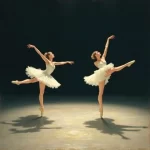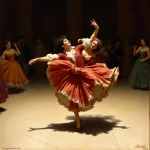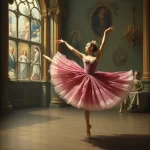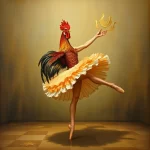Ballet: Les Noces (Igor Stravinsky, 1923)

Introduction
Ballet, as an art form, has seen numerous masterpieces that have stood the test of time. One such work is Les Noces (The Wedding), a ballet composed by Igor Stravinsky in 1923. This ballet is a unique blend of music, dance, and cultural storytelling, brought to life through the collaboration of Stravinsky and choreographer Bronislava Nijinska. Premiering on June 13, 1923, at the Théâtre de la Gaîté in Paris, Les Noces offers a poignant depiction of a traditional Russian peasant wedding, exploring themes of community, ritual, and the passage of life.
Historical Background
Creation and Development
Les Noces was created during a period of significant artistic experimentation and innovation. The early 20th century was marked by a fascination with primitivism, folklore, and the avant-garde. Stravinsky, already renowned for his groundbreaking works like The Firebird and The Rite of Spring, sought to explore the raw, communal aspects of Russian peasant life. The inspiration for Les Noces came from Russian wedding rituals, which Stravinsky had observed and found deeply moving.
The collaboration between Stravinsky and Nijinska was crucial to the development of the ballet. Nijinska, the sister of the famous dancer Vaslav Nijinsky, brought her own innovative vision to the choreography, emphasizing the communal and ritualistic aspects of the wedding. The ballet also involved contributions from other key figures, including set designer Natalia Goncharova and conductor Ernest Ansermet.
Premiere and Reception
Les Noces premiered on June 13, 1923, at the Théâtre de la Gaîté in Paris. The initial reception was mixed, with some critics praising its originality and others finding it too avant-garde. However, the ballet quickly gained recognition for its innovative approach to both music and dance. Notable early performances included revivals by the Ballets Russes and later by various international ballet companies.
Synopsis of the Ballet
Les Noces is a one-act ballet that unfolds in a series of scenes depicting the various stages of a traditional Russian peasant wedding. The ballet is divided into four tableaux:
- Tableau I: The Bride’s House – The bride prepares for her wedding, surrounded by her family and friends. The scene is filled with rituals and blessings.
- Tableau II: The Groom’s House – The groom and his family prepare for the wedding. This scene mirrors the bride’s preparations, emphasizing the communal nature of the event.
- Tableau III: The Departure – The bride and groom leave their respective homes and travel to the church. This scene is marked by a sense of anticipation and transition.
- Tableau IV: The Wedding Feast – The final scene depicts the wedding feast, where the community comes together to celebrate the union. The ballet concludes with a sense of communal joy and continuity.
Musical Composition
Composer’s Role
Igor Stravinsky’s contribution to Les Noces is monumental. Known for his innovative and often controversial compositions, Stravinsky created a score that is both stark and powerful. The music for Les Noces is scored for four pianos, percussion, and a mixed chorus, creating a unique sound that reflects the raw, earthy quality of the wedding rituals. Notable pieces within the score include the choral sections that punctuate the action and the rhythmic, percussive elements that drive the dance.
Musical Themes and Motifs
The music of Les Noces is characterized by its use of repetitive, rhythmic motifs that evoke the ritualistic nature of the wedding. Stravinsky employs folk melodies and harmonies, creating a soundscape that is both modern and deeply rooted in tradition. The music enhances the narrative by underscoring the communal and cyclical aspects of the wedding, with recurring themes that reflect the continuity of life and tradition.
Famous Recordings and Performances
Over the years, Les Noces has been recorded by numerous orchestras and conductors, each bringing their own interpretation to the score. Notable recordings include those conducted by Pierre Boulez, Leonard Bernstein, and Valery Gergiev. These recordings have helped to cement the ballet’s place in the classical music repertoire and have introduced new audiences to Stravinsky’s innovative work.
Choreography and Dance
Choreographer’s Vision
Bronislava Nijinska’s choreography for Les Noces is a masterful blend of traditional folk dance and modernist abstraction. Nijinska sought to capture the communal and ritualistic aspects of the wedding, using group formations and repetitive movements to evoke the sense of a collective experience. Her choreography is marked by its use of geometric patterns and stark, angular movements, reflecting the raw, primal energy of the music.
Signature Dance Numbers
Key dance numbers in Les Noces include the bride’s preparation scene, where the dancers perform intricate hand and arm movements that mimic traditional wedding rituals. Another notable scene is the departure, where the dancers’ movements convey a sense of transition and anticipation. The final wedding feast is a tour de force of group choreography, with the dancers moving in unison to create a sense of communal celebration.
Notable Interpretations
Over the years, different productions of Les Noces have brought their own interpretations to the choreography. Some have emphasized the folk elements, while others have focused on the modernist aspects of Nijinska’s vision. Notable productions include those by the Royal Ballet, the Paris Opera Ballet, and the Bolshoi Ballet, each of which has brought its own unique perspective to the work.
Characters and Roles
Main Characters
The main characters in Les Noces are the bride and groom, who are central to the narrative. The bride is depicted as a young woman preparing for her new life, while the groom is shown as a figure of strength and stability. Both characters are surrounded by their families and friends, who play important roles in the wedding rituals.
Supporting Characters
Supporting characters include the parents of the bride and groom, who bless the couple and oversee the preparations. There are also various friends and community members who participate in the rituals and celebrations, adding to the sense of a communal event.
Famous Dancers
Over the years, many notable dancers have portrayed the roles in Les Noces. These include Alicia Markova, who was one of the original cast members, and more recent performers like Natalia Osipova and Ivan Vasiliev, who have brought their own interpretations to the roles.
Cultural and Artistic Impact
Influence on Ballet and Dance
Les Noces has had a significant influence on the world of ballet and dance. Its innovative use of music and choreography has inspired countless choreographers and composers. The ballet’s emphasis on communal and ritualistic elements has also influenced other works that explore similar themes.
Cultural Significance
Les Noces holds a special place in popular culture and has been referenced in various forms of media. Its depiction of traditional Russian wedding rituals has been celebrated for its authenticity and emotional depth. The ballet has also been adapted into other art forms, including film and theater, further cementing its cultural significance.
Legacy and Revivals
The legacy of Les Noces is evident in the numerous revivals and reinterpretations that continue to be performed today. Major ballet companies around the world regularly include Les Noces in their repertoires, ensuring that new generations of audiences can experience this groundbreaking work. Modern adaptations have also brought fresh perspectives to the ballet, highlighting its timeless themes and innovative artistry.
Iconic Productions
Historic Productions
Some of the most famous historical productions of Les Noces include its original performances by the Ballets Russes, under the direction of Sergei Diaghilev. These early productions set the standard for future interpretations and featured some of the most renowned dancers and choreographers of the time.
Contemporary Productions
Recent productions of Les Noces have continued to explore new interpretations of the ballet. Companies like the Royal Ballet and the Paris Opera Ballet have brought their own unique visions to the work, incorporating modern elements while staying true to the original spirit of the ballet.
Production Design
The production design of Les Noces has evolved over the years, with different productions bringing their own aesthetic sensibilities to the ballet. Set and costume designs have ranged from traditional Russian folk elements to more abstract, modernist interpretations. Lighting design has also played a crucial role in creating the mood and atmosphere of the ballet, enhancing the emotional impact of the performance.
Critical Reception and Reviews
Initial Critical Response
The initial critical response to Les Noces was mixed, with some critics praising its originality and others finding it too avant-garde. However, over time, the ballet has come to be recognized as a masterpiece of 20th-century art, celebrated for its innovative use of music and choreography.
Modern Reviews
Contemporary critics and audiences continue to hold Les Noces in high regard. Modern reviews often highlight the ballet’s emotional depth and its powerful depiction of communal rituals. The ballet’s relevance today is seen in its exploration of universal themes like love, community, and tradition.
Fun Facts and Trivia
Behind-the-Scenes Stories
One interesting anecdote from the production of Les Noces involves Stravinsky’s insistence on using four pianos in the score. This unusual choice was initially met with skepticism, but it ultimately contributed to the unique sound of the ballet.
Notable Performers
Over the years, many famous dancers, conductors, and directors have been associated with Les Noces. These include choreographers like Jerome Robbins and dancers like Alicia Markova, who have brought their own interpretations to the work.
Trivia
- Les Noces was originally conceived as a ballet with a full orchestra, but Stravinsky later decided to use four pianos and percussion instead.
- The ballet’s title, Les Noces, means “The Wedding” in French, reflecting its focus on traditional wedding rituals.
- Stravinsky’s use of folk melodies and rhythms in the score was inspired by his own experiences of Russian peasant life.
Conclusion
Summary of the Ballet’s Importance
Les Noces is a significant work in the world of ballet, celebrated for its innovative use of music and choreography. Its depiction of traditional Russian wedding rituals offers a poignant exploration of themes like community, tradition, and the passage of life.
Final Thoughts
Les Noces remains a powerful and relevant work today, continuing to inspire new generations of artists and audiences. Its unique blend of music, dance, and cultural storytelling makes it a timeless masterpiece that deserves to be experienced by all.
FAQ
What is the central theme of this ballet?
The central theme of Les Noces is the depiction of a traditional Russian peasant wedding, exploring themes of community, ritual, and the passage of life.
Who are the main characters in this ballet?
The main characters in Les Noces are the bride and groom, who are central to the narrative. They are surrounded by their families and friends, who play important roles in the wedding rituals.
What is the most famous dance number in this ballet?
One of the most famous dance numbers in Les Noces is the final wedding feast, where the dancers move in unison to create a sense of communal celebration.
How long does a typical performance of this ballet last?
A typical performance of Les Noces lasts approximately 25-30 minutes, as it is a one-act ballet.
Are there any modern adaptations of this ballet?
Yes, there have been numerous modern adaptations and reinterpretations of Les Noces, with different ballet companies bringing their own unique perspectives to the work.
Why is this ballet considered important in the history of dance?
Les Noces is considered important in the history of dance for its innovative use of music and choreography, as well as its powerful depiction of communal rituals and traditions. It has had a significant influence on other works and continues to be celebrated today.





